
철원지역 한탄강 베개용암의 분포와 특징
초록
철원지역 한탄강 일대에는 4매의 용암류 단위가 관찰되며, 용암류 단위 2의 하부 경계 주변을 따라 베개용암이 분포한다. 직탕폭포 일대의 베개용암은 용암류 단위 1과 2의 경계면을 따라 나타나며, 가장자리 급냉대가 발달한 원형 또는 타원형의 로브들이 포개진 형태를 보인다. 승일교와 고석정 일대의 베개용암은 기반암과 용암류 단위 2의 경계면을 따라 나타난다. 기반암 경계 주변에서 (타)원형의 베개용암 로브들은 비접촉 상태로 퇴적물에 둘러싸인 양상을 보이지만 상부로 갈수록 로브들이 서로 접촉되고 포개진 형태로 변해간다. 로브의 표면에는 공통적으로 가로 및 세로 확장균열과 수축절리 및 주름구조가 발달한다. 철원지역 한탄강 일대는 용암류가 분출하기 이전에 화강암을 기반으로 물이 흐르고 침식이 일어나는 하천환경이었다. 최초 용암류(용암류 단위 1)가 하천을 따라 흐르면서 장애물을 만나거나 점성이 증가하면서 크고 작은 언덕지형을 형성하였다. 그리고 화산활동이 다시 발생하여 용암류 단위 2가 하천으로 흘러들어 일부가 물웅덩이로 들어가면서 베개용암을 형성하였다. 물웅덩이에 퇴적물이 없었던 직탕폭포 일대는 로브들이 차곡차곡 누적된 베개용암이 형성되었다. 반면 물웅덩이에 하성 퇴적물이 쌓여 있던 승일교와 고석정 일대는 용암이 미고화된 퇴적층 위를 흐르면서 퇴적물과 로브들이 불규칙하게 섞여 있는 형태의 베개용암을 형성한 것으로 추정된다. 베개용암은 철원지역 용암류의 특성을 파악하고 용암류 단위를 구분하며, 퇴적환경을 해석하는 데 있어 중요한 증거이다. 또한 베개용암의 분포와 특징은 철원지역 지질명소와 연계하여 중요한 지질 유산으로 활용될 수 있을 것이다.
Abstract
Along the Hantangang River in the Cheorwon region, four lava flow units are observed. Pillow lava occurs at the base of Lava Flow Unit 2. The pillow lava near the Jiktang Falls occurs along the boundary between Lava Flow Units 1 and 2, where the lobes and stacking patterns of the (elliptical) cylindrical lava lobes with chilled margins are observed. The pillow lava near the Seungilgyo Bridge and Goseokjeong Pavilion occurs along the boundary between the basement rock and Lava Flow Unit 2. The (elliptical) cylindrical lobes of the pillow lava are enclosed in sediment near the contact with the basement rock, whereas the lobes are in contact with each other and transform into a stacked formation as they move towards the upper part. The pillow lavas at these localities share some features in common, including transverse and longitudinal spreading cracks and contraction joints alongside corrugated structures. Prior to the eruption of lava, the Hantangang River area in the Cheorwon region was a fluvial environment where the granitic basement was incised by flowing water. The initial lava flow (Lava Flow Unit 1) flowed into the river and formed an extensive hummocky topography. Following the resumption of volcanic activity, Unit 2 lava flow flowed into the river, forming pillow lava as it entered the pools of the river. The pillow lava lobes in the Jiktang Falls area that lacked pool sediment accumulated one upon the other. In the Seungilgyo Bridge and Goseokjeong areas with accumulated fluvial sediment, however, the pillow lava lobes were irregularly mixed with sediment. Pillow lava provides important evidence for identifying lava flow properties, defining lava flow units, and interpreting the sedimentary environment in the Cheorwon region. In addition, the distribution and characteristics of the pillow lava can be used for the utilization of the geological heritage in connection with the geological attractions in the Cheorwon region.
Keywords:
Hantangang River, UNESCO Global Geopark, Cheorwon-gun, pillow lava키워드:
한탄강, 유네스코 세계지질공원, 철원군, 베개용암1. 서 론
베개용암(pillow lava)은 용암이 물속에서 분출하거나 육상에서 물속으로 흘러 들어가 급격히 냉각되어 만들어진 길쭉한 자루(sack-like) 또는 파이프 모양의 용암을 말한다(Jones, 1969; Walker, 1992; Schmidt and Schmincke, 2000). 베개용암은 뜨거운 용암과 물의 반응을 지시하는 구조로서 중앙해령뿐만 아니라 바다(Goto and McPhie, 2004, 2012; Johns et al., 2006), 호수(McClintock et al., 2008), 하천(Moraes and Seer, 2018), 빙하지형(Jones, 1969; Edwards et al., 2009) 등에서 형성될 수 있다. 베개용암은 용암의 온도, 점성, 냉각속도, 경사각의 차이와 함께 물의 온도, 압력, 수심, 성분 등에 따라 다양한 형태로 나타날 수 있어 이에 관한 연구를 통해 형성 시기 및 과정, 퇴적환경에 대한 정보를 얻을 수 있다(Yamagishi, 1991).
한탄강 유네스코 세계지질공원은 철원군, 포천시, 연천군 일대의 하천 침식으로 형성된 현무암의 독특한 지형 및 지질유산을 기반으로 한다(Kil et al., 2019). 한탄강 일대는 추가령 구조곡에서 발생한 열하분출로 용암류가 여러 차례 북쪽과 남쪽으로 흐르면서 용암대지 및 하도 충전지형을 형성한 것으로 알려져 있다(Won, 1983; Lee and Lee, 2016; Lee et al., 2020).
연구지역인 철원군 일대의 한탄강 단면에서는 4매의 용암류 단위가 관찰되며, 용암류 단위 사이 또는 기반암과의 경계면을 따라 국부적으로 베개용암이 분포한다. 베개용암은 산출지역에 따라 크기, 모양, 표면구조 등에 차이를 보이는데, 본 연구는 철원지역 베개용암의 분포와 형태적 특징, 형성과정에 대해 연구하였다. 철원지역 베개용암 연구는 한탄강 상류지역 용암류의 특성과 용암류가 강을 따라 흐르면서 발생한 다양한 화산작용과 퇴적환경을 이해한다는 측면에서도 중요한 의미가 있다. 또한 베개용암의 독특한 특징과 내부구조에 대한 연구는 한탄강 일대의 지질학적 이해를 높이고 교육자원으로 활용될 수 있을 것이다.
2. 지질개요
2.1 한탄강 일대의 광역 지질
한탄강 일대의 용암류 기원과 정치과정에 대해서는 오래전부터 많은 연구가 진행되어 왔다. Won (1983), Won et al. (2015)에 따르면, 한탄강의 용암분출은 주로 평강군 오리산(453 m)과 검불랑 북쪽 성산(680 m)을 잇는 선을 중심으로 이루어졌으며, 이들 봉우리는 열하분출(fissure eruption) 말기에 형성되었다고 해석한 바 있다. 그리고 Lee and Lee. (2016)는 서울과 원산을 잇는 추가령 구조곡에서 발생한 열하분출로 용암분출의 중심부에 가까운 철원군 북부 지역은 넓은 면적의 용암대지가 발달하고 하류를 따라서는 하곡을 메운 좁고 긴 모양의 용암대지를 형성한 것으로 해석하였다(Lee and Lee, 2016; Lee et al., 2020).
연구지역은 북에서 남으로 흐르는 한탄강 본류의 상류에 위치한다(그림 1). 연구지역 중 남쪽에 위치하는 승일교와 고석정 인근은 한탄강이 감입곡류하고 있고, 지천인 대교천이 합류한다. 한탄강의 하상면은 해발 약 145 m이고 인근 대지의 해발은 약 175 m로 한탄강 계곡은 약 30 m 높이의 절벽을 이룬다.
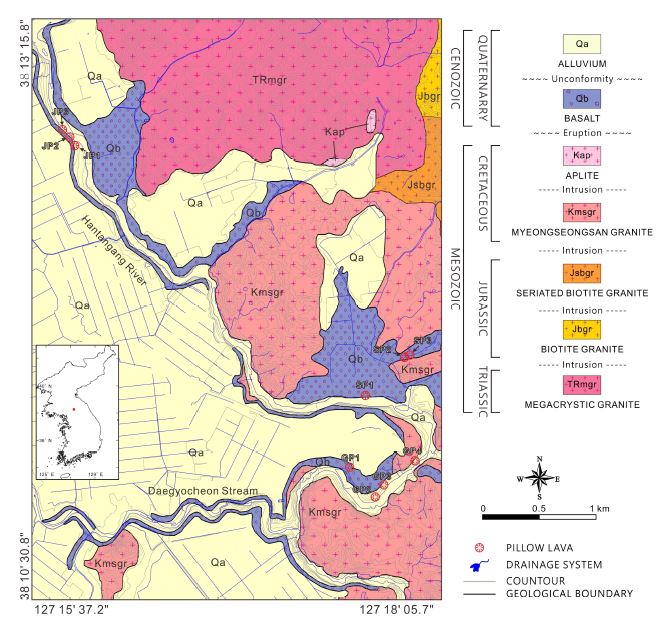
Geological map of the Hantangang River in the Cheorwon region (Song and Cho, 2007). Pillow lava was confirmed at a total of ten localities, which are classified by area into Jiktang Falls (JP), Seungilgyo Bridge (SP), and Goseokjeong (GP).
연구지역인 한탄강 철원지역 일대는 중생대 트라이아스기 거정질 화강암을 기반으로 쥐라기 흑운모 화강암과 세리에이트질 흑운모 화강암, 백악기 명성산 화강암과 반화강암이 분포하고, 신생대 제4기 화산활동으로 형성된 현무암과 이를 피복하는 충적층이 발달한다(그림 1; Song and Cho, 2007).
2.2 철원지역 한탄강 용암류의 구성
일반적으로 용암류는 연속적으로 분포하는 독립된 용암의 흐름 단위를 말한다(MacDonald, 1953). 용암로브(lava lobe)는 냉각대에 둘러싸인 소규모의 용암 단위를 말하며 크기, 형태, 연장성 등에 따라 용암 발가락(lava toes), 시트상 로브(sheet lobes) 등으로 구분된다(Self et al., 1997, 1998; Thordarson and Self, 1998).
직탕폭포 인근에서 고석정 일대까지 분포하는 철원지역 한탄강 용암류는 산출고도, 암상, 두께, 연장성, 절리발달 등을 기준으로 4개의 용암류 단위로 구분하였다(그림 2). 최하부 용암류 단위 1은 기반암과 접하며 볼록하게 솟은 언덕(hummocky) 지형이 반복되는 형태로 나타나고, 내부에 방사상절리(radial joint)가 발달한다. 용암류 단위 2는 용암류 단위 1의 지형기복을 채우고 있으며 지역에 따라 기반암과 직접 접하며 나타나기도 한다. 용암류 단위 2는 주상절리가 잘 발달한 두꺼운 시트상 용암류의 특징을 보인다. 용암류 단위 3은 수매의 시트상 용암류가 중첩된 양상을 보아며 용암류의 상하부에 다공질 구간이 잘 발달한다. 용암류 단위 4는 철원지역 최상부 용암류로서 수매의 시트상 용암류가 누적된 형태로 산출된다. 현재 철원지역 한탄강 용암류의 분포, 연장성, 단위구분, 형성시기에 대한 연구가 진행 중이며 별도 논문으로 발표할 예정이다. 본 논문에서는 베개용암의 산출지를 상류에서 하류까지 직탕폭포(JP), 승일교(SP), 고석정(GP)의 3개 구간으로 구분하여 기술하였다.
3. 철원지역 베개용암의 산출 및 특징
3.1 직탕폭포 일대
직탕폭포 일대에서 베개용암은 용암류 단위 2의 하부 경계면을 따라 나타나며 3개 지점에서 확인된다(그림 2, 3a). 용암류 단위 2의 두께는 최대 10 m이고 감람석 반정을 포함하고 있다.

Pillow lava around Jiktang Falls. (a) Classification of lava flow units and distribution of pillow lava (yellow cycles). (b) The contact between the upper part of Lava Flow Unit 1 and the pillow lava. Differences in color and vesicle content between Lava Unit 1 and the pillow lava are also evident, among others. (c) Pillow lava with overlapping large and small lobes (the white arrows indicate the flow direction of the lobes). The yellow line indicates the transverse spreading cracks. (d) Close-up of the pillow lava lobes displaying radial joints within each lobe. Transverse spreading cracks (yellow arrows), contraction joints (blue arrows), are displayed on the surface. The space between the pillow lava lobes is filled with yellowish palagonite.
베개용암은 용암류 단위 2의 하부에서 용암류 단위 1의 경계까지 최대 7 m 두께 범위에서 나타난다(그림 2, 3b). 베개용암 로브들은 길쭉한 자루나 파이프 모양으로 뻗어 나와 서로 중첩된 형태를 보인다(그림 3b, 3c). 단면상에서 로브의 직경은 약 0.5-1 m 내외이며, 형태는 원형에서 타원형을 보이는 경우가 많고 불규칙한 형태로 나타나기도 한다(그림 3d). 베개용암 로브의 표면에는 검은색에서 적갈색을 띠는 급냉대가 나타나며 내부에는 방사상절리가 잘 발달해 있다. 로브의 표면에는 성장하던 베개용암 로브가 굳어지면서 갈라진 틈인 확장균열(spreading crack) 들이 관찰된다(e.g., Fuller, 1932; Moore, 1975; Moore and Lockwood, 1978; Goto and McPhie, 2012). 확장균열은 방향에 따라 세로(longitudinal) 및 가로(transverse) 확장균열로 구분되는데(McPhie et al., 1993), 직탕폭포 일대에서는 가로 확장균열이 관찰된다(그림 3c, 3d). 로브의 흐름방향에 수직으로 갈라진 가로 확장균열은 마치 치약을 짜는 것처럼 로브가 전진하는 형태에서 각 마디가 끊어진 형태이며, 단면상에서는 계단모양으로 나타난다(그림 3c, 3d). 또한 하나의 로브에서 두 개 또는 세 개로 분기되면서 전진하는 형태의 교차(three intersecting) 확장균열도 관찰된다(그림 3c). 한편 로브의 표면 곳곳에는 수축절리(contraction crack)가 발달하며, 잔물결처럼 주름진(corrugations) 구조들도 나타난다(그림 3d). 베개용암 로브와 로브 사이는 대부분 눌어붙어 공극이 거의 없으나 일부는 황갈색의 팔라고나이트(palagonite)로 채워진 부분도 있다.
슬랩상에서 직탕폭포 일대 베개용암 로브의 가장자리는 검은색 또는 적갈색을 띠며 1-3 cm 두께의 유리질 급냉대가 발달한다(그림 4a). 이 급냉대는 신선한 부분에서 검은색 유리처럼 반짝거리는 질감을 보이며, 풍화 변질된 경우 적갈색 또는 황갈색으로 나타난다. 로브의 안쪽 부분은 암회색 또는 회색을 띠며 일정한 크기의 사장석과 감람석 반정이 포함된 형태로 나타난다. 로브의 가장자리와 내부에 상관없이 감람석 반정은 공통적으로 비슷한 크기로 분포한다(그림 4a, 4b).
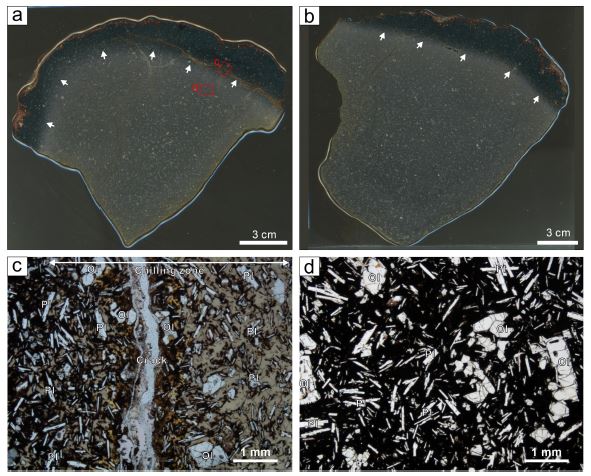
Photographs of the slabs and thin sections of the pillow lava at Jiktang Falls. (a & b) The slabs of the Jiktang Falls pillow lava. (Arrows: the glassy rim / Red box: thin section observation point). (c) Photograph of the glassy rim (right part) and tachylitic interior (left part) of the pillow lava. (d) The thin section of the inner portion of the pillow lava with tachylitic groundmass. Pl: Plagioclase; Ol: Olivine; c & d: open nicol.
현미경하에서 베개용암 로브는 감람석 반정 및 미반정과 다량의 래스(lath)상의 사장석으로 구성되고, 유리질 기질이 반정을 에워싸는 하이알로오피틱(hyalo-ophitic) 조직을 보인다(그림4c, 4d). 베개용암 로브 가장자리 부분의 기질은 연갈색 또는 황갈색의 투명한 유리인 시데로멜레인(sideromelane)으로 구성되어 있다(그림 4c). 반면 베개용암 로브의 중심부의 기질은 흑색의 불투명 유리인 타킬라이트(tachylite)로 구성되어 있다(그림 4d). 급냉대와 중심부의 경계부에는 시데로멜레인과 타킬라이트가 혼재하는 점이적 양상을 보인다.
3.2 승일교 일대
승일교 일대의 베개용암은 용암류 단위 2의 하부에 나타나며, 총 3개 지점에서 확인된다(그림 1, 5). 기반암(풍화된 명성산 화강암) 상부에 위치한 용암류 단위 2는 한탄강 지류 하천 바닥에서 약 1-2 m 상부에 위치해 있다. 용암류 단위 2는 괴상 용암류로서 내부에는 방사상절리 또는 주상절리가 발달하며 감람석 반정을 포함하고 있다(그림 5a).

Pillow lava in the area of Seungilgyo Bridge. (a) Pillow lava distributed above the basement rock (granite residual soil). The size of the pillow lava lobes decreases toward the granite residue of the basement rock. (b) The distribution of lobe-shaped pillow lava in the lower part of Lava Flow Unit 2 in contact with the basement rock.
베개용암은 용암류 단위 2의 하부에서 기반암까지 최대 5 m 범위에서 나타난다(그림 6a). 용암류 단위 2의 하부에서 연장된 로브들은 기반암 쪽으로 뻗어나간 형태를 보이는데, 마치 용암류 하부에서 빠져나온 큰 로브가 아래쪽으로 갈수록 손가락 모양으로 갈라져 뻗어나간 형태와 유사하다. 로브는 기반암에 가까워질수록 크기가 작아지고 가장자리에 급냉대가 발달한 베개용암의 특징이 뚜렷해지는 경향을 보인다(그림 6b). 기반암과 베개용암의 접촉부 주변에는 풍화된 화강암 토양 사이에 베개용암 로브들이 섞여 있는(또는 뚫고 나온) 양상을 보인다(그림 6c). 로브의 직경은 수십 cm에서 1 m 이상이며, 형태는 단면상에서 불규칙한 원형 또는 타원형뿐만 아니라 다양한 유동형으로 나타난다(그림 6b). 로브의 표면에는 검은색 또는 적갈색의 급냉대가 발달해 있고 내부에 방사상절리가 잘 발달한다(그림 6c). 일부 로브의 전면부에서는 흐름방향에 수직으로 발달한 가로 확장균열도 나타난다(그림 6d). 로브의 표면에는 형태에 상관없이 흐름방향에 나란한 세로 확장균열을 비롯하여 수축절리와 주름구조도 나타난다(그림 6d).
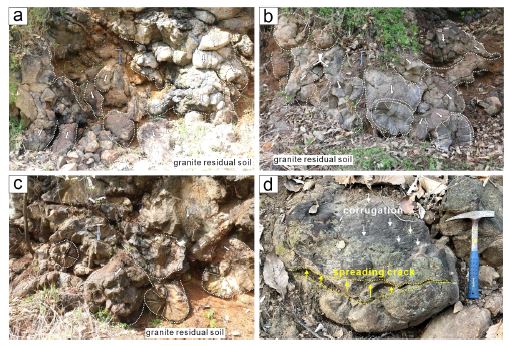
The characteristics of the pillow lava between Lava Flow Unit 2 and the basement rock. (a) The lava lobe extending toward the basement rock in the lower part of Lava Flow Unit 2. (b) The small lobes extending sideways from the larger lobe. (c) The radial joint in the interior of the lobe with chilled margins displayed on the surface. (d) Transverse spreading cracks (yellow arrows) developed on the front of the lobe with corrugations (white arrows) on the lobe surface.
슬랩상에서 베개용암 로브의 단면은 암색과 결정화 정도에 차이를 보이는데, 로브의 중심부는 일반적인 용암류와 유사하지만 가장자리 부분은 유리질 급냉대가 발달한다(그림 7a, 7b). 급냉대의 표면부를 따라 약 1-5 mm 두께의 적갈색의 변질대가 관찰된다. 그리고 변질대 아래에는 1-2 cm 두께로 암회색을 띠는 유리질 급냉대가 발달한다. 로브의 가장자리와 내부에 상관없이 감람석 반정은 공통적으로 비슷한 크기로 분포한다(그림 7a, 7b).
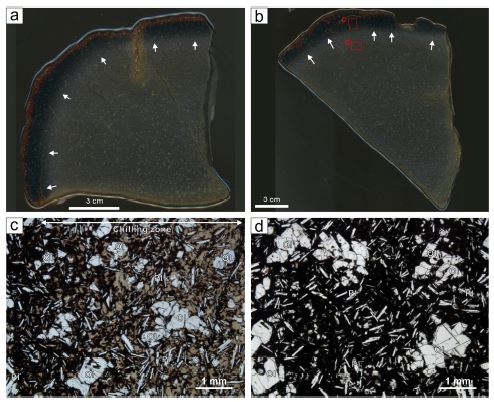
Photographs of the slabs and thin sections of the pillow lava at Seunggilgyo Bridge. (a & b) The slabs of the Seungilgyo Bridge (Arrows: chilled margin glassy rim / Red box: thin section observation point). (c) Photograph of the glassy rim (right part) and tachylitic interior (left part) of the pillow lava. (d) The thin section of the inner portion of the pillow lava with tachylitic groundmass. Pl: Plagioclase; Ol: Olivine; c & d: open nicol.
현미경하에서 승일교 일대의 베개용암은 급냉대와 중심부로 구분되며, 급냉대의 기질은 시데로멜레인으로 구성되고, 중심부의 기질은 타킬라이트로 구성된다. 또한 급냉대와 중심부의 경계부에는 시데로멜레인과 타킬라이트가 혼재하는 점이적 양상을 보인다(그림 7c, 7d). 이러한 조직특성은 직탕폭포의 베개용암과 동일한 현미경적인 특징을 보인다.
3.3 고석정
고석정 일대의 베개용암은 용암류 단위 2의 하부에 분포하며, 총 4개 지점에서 확인된다(그림 8). 용암류 단위 2는 두께가 약 10-15 m 내외이며 강바닥에서 약 15-20 m 상부 절벽에 분포한다(그림 8).
베개용암은 용암류 단위 2의 하부에서 기반암까지 최대 약 5 m 두께로 분포한다. 용암류 단위 2의 하부에서 연장된 로브들은 자루모양으로 기반암 쪽으로 뻗어나간 형태를 보이며 일부 로브는 중첩된 형태로 나타나기도 한다. 로브들의 중첩 비율은 하부로 갈수록 감소하는 경향을 보이는데, 기반암 주변에서는 로브가 화강암 풍화토로 둘러싸인 형태로 나타난다.
단면상에서 베개용암의 로브는 원형에서 아원형을 띠고 있으며, 불규칙한 유동형으로 나타나기도 한다(그림 9a). 로브의 직경은 수십 cm에서 1 m 내외이며 내부에는 방사상절리가 잘 발달되어 있다(그림 9a-9c). 베개용암 로브의 표면에는 검은색에서 적갈색을 띠는 급냉대가 발달한다. 일부 로브의 표면에는 흐름방향에 나란하게 주름지거나 찢어진 세로 확장균열들이 발달한다(그림 9d). 세로 확장균열 구조는 중심축(axial crack)을 기준으로 약 10 cm 범위에서 좌우로 확장된 양상이며 단면상에서 v형태 또는 지구(graben-like) 모양으로 오목하게 내려앉은 양상을 보인다. 로브의 가장자리 표면은 대부분 적갈색으로 변질되어 있으나 일부 신선한 부분에서는 검은색 유리질의 특징을 보인다(그림 9d).

Pillow lava at Goseokjeong Pavilion. (a) Accumulation of pillow lava lobes displaying well-developed radial joints. (b) Pillow lava lobes with transverse spreading crack structures (yellow arrows). (c) Pillow lava with well-developed radial joints. (d) Longitudinal spreading cracks on the lobe surface and a graben-like concave recessive feature.
슬랩상에서 베개용암 로브의 가장자리는 검은색 또는 암회색을 띠며 1-3 cm 두께의 유리질 급냉대가 발달하며, 풍화 변질로 인해 적갈색으로 나타나기도 한다(그림 10).
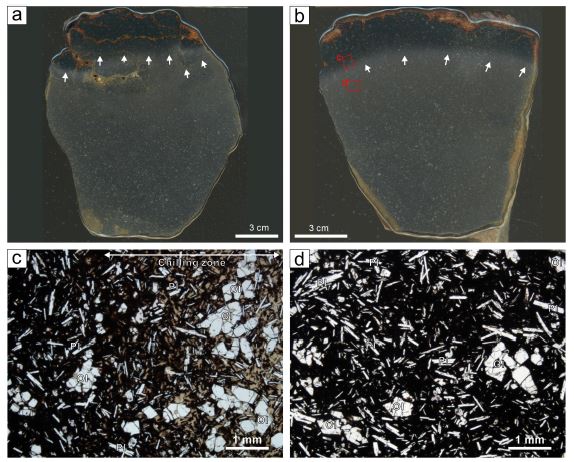
Photographs of the slabs and thin sections of the pillow lava at Goseokjeong Pavilion. (a & b) The slabs of the Goseokjeong Pavilion pillow lava (Arrows: chilled margin glassy rim / Red box: thin section observation point). (c) Photograph of the glassy rim (right part) and tachylitic interior (left part) of the pillow lava. (d) The thin section of the inner portion of the pillow lava with tachylitic groundmass. Pl: Plagioclase; Ol: Olivine; c & d: open nicol.
현미경하에서 고석정 일대의 베개용암은 급냉대와 중심부로 구분되며, 급냉대의 기질은 시데로멜레인으로 구성되고, 중심부의 기질은 타킬라이트로 구성된다. 또한 급냉대와 중심부의 경계부에는 시데로멜레인과 타킬라이트가 혼재하는 점이적 양상을 보인다(그림 10c, 10d). 이러한 조직특성은 직탕폭포와 승일교 일대의 베개용암과 동일한 현미경적인 특징을 보인다.
4. 철원지역 베개용암의 특징과 형성과정
철원지역 한탄강 일대 베개용암은 용암류 단위 2의 하부에 분포하며, 3개 구역, 10개 지점에서 확인된다. 용암류 단위 1은 승일교와 고석정 일대에는 나타나지 않는데, 이는 이 일대가 과거 상대적으로 높은 고도에 위치하여 용암류 단위 1이 도달하지 못한 것으로 추정된다.
직탕폭포 일대의 베개용암은 비슷한 크기의 로브들이 포개진 양상을 보인다. 이는 일정한 수심을 가진 물웅덩이로 용암이 들어가면서 급냉에 의해 로브들이 차곡차곡 누적된 결과로 추정된다. 직탕폭포 일대의 베개용암은 수평적으로 고도에 따라 단속적인 분포를 보이고 있는데(그림 2), 고도가 낮은 북쪽의 베개용암이 먼저 형성되고 이에 따라 하천의 유로가 바뀌고 보다 낮은 고도에 새로운 유로가 형성되면서 베개용암의 산출 위치가 변경된 것으로 추정된다. 그리고 베개용암 분포 구간의 두께가 4-7 m임을 고려할 때 당시 용암류 1의 상부에 하천이 발달하면서 국부적으로 형성된 물웅덩이의 수심도 비슷한 깊이였을 것으로 추정된다. 직탕폭포 일대 베개용암 로브들의 마디가 단속적으로 끊어진 가로 확장균열은 베개용암 로브가 만들어지고 굳어가면서 그 전단부를 뚫고 다시 로브가 전진하면서 급격히 식으면서 형성된 것으로 해석된다(e.g., Yamagishi, 1991; 그림 3c).
승일교와 고석정 일대의 베개용암은 용암류 하부에 크고 작은 로브들이 중첩된 형태로 나타나지만 하부 기반암 쪽에 가까워질수록 로브의 크기가 작아지고 산출빈도가 감소하며 퇴적물에 둘러싸인 형태로 변해가는 특징을 보인다. 이러한 특징은 승일교와 고석정 일대로 흘러온 용암이 물웅덩이 바닥에 쌓인 퇴적물과 섞이면서 퇴적물에 둘러싸인 형태의 베개용암을 형성하고 그 상부에는 단순히 물에 의한 냉각으로 로브들이 차곡차곡 누적된 형태의 베게용암이 형성되었음을 말해준다. 이와 같이 용암이 호수나 수심이 얕은 하천 퇴적층 위를 흐를 경우 두 유체 사이의 격렬한 수증기성 폭발에 의해 소규모 폭발이 일어나 용암과 퇴적물이 깨지고 섞이면서 형성되는 베개형 각력암(pillow breccia)과 유사한 것으로 해석된다(e.g., Yamagishi, 1991). 그리고 로브의 표면에 나타나는 세로 확장균열(그림 7d)은 로브가 흐를 때 표면은 급냉하지만 내부는 뜨거운 상태를 유지하고 용암의 공급 증가로 내부 압력이 높아져 팽창하면서 표면을 찢으면서 만든 구조로 해석된다(Moore, 1975). 베개용암 로브의 형태와 상관없이 표면에는 흐름방향과 나란하게 잔물결처럼 주름진 구조들이 발달하는데 이는 로브의 팽창(inflation or growth)과 급격한 수축이 반복된 결과로 해석된다(Moore 1975; Moore and Lockwood, 1978).
철원지역 한탄강 일대는 용암류가 분출하기 이전에 화강암을 기반으로 물이 흐르고 지속적인 침식작용이 일어나는 하천환경이었다(Lee and Lee, 2016; Lee et al., 2020). 이후 화산활동이 발생하여 용암이 하천을 따라 좁고 길쭉한 형태로 흘렀으며, 국부적인 인플레이션(inflation) 등으로 볼록한 언덕지형을 형성하였다. 이후 용암류 단위 2가 용암류 단위 1의 지형 기복을 채우면서 흐르다가 지면에 형성된 요지 또는 물웅덩이 내부를 흘러들어 급냉하면서 직탕폭포 일대와 같이 로브들이 차곡차곡 쌓인 형태의 베개용암을 형성하였다. 그리고 일부는 퇴적물이 쌓인 물웅덩이 등으로 용암이 유입되면서 승일교와 고석정 일대와 같이 용암 하부에 퇴적물과 뒤섞인 형태의 베개용암이 만들고 그 상부에 베개용암이 차곡차곡 누적된 양상으로 나타나게 된 것으로 해석된다.
용암류 단위 2의 하부에만 베개용암이 분포하는 원인은 용암류 분출이후 지형의 변화에 따른 하천의 유로 변경, 고하천의 지속여부, 고기후 패턴의 변화, 화산분출의 주기 및 양상 등의 가능성이 있으며, 향후 추가 연구가 필요할 것으로 생각된다.
5. 결 론
유네스코 세계지질공원으로 지정된 한탄강 일대는 하천의 침식으로 형성된 현무암의 독특한 지형 및 지질유산을 보유하고 있다. 연구지역인 철원군 일대의 한탄강 단면에서는 4매의 용암류 단위가 관찰된다. 베개용암은 용암류 단위 2의 하부에 분포하며, 3개 구간(직탕폭포, 승일교, 고석정), 10개 지점에서 확인된다.
직탕폭포 일대의 베개용암은 약 수십 cm 직경의 원형 및 타원형 로브들이 파이프처럼 뻗어 나와 겹겹이 포개진 형태를 보인다. 로브 내부에는 방사상절리가 발달하며, 표면에는 유리질 급냉대를 비롯하여 가로 확장균열, 수축절리, 주름구조가 관찰된다. 승일교와 고석정 일대의 베개용암은 기반암 경계 주변에서는 (타)원형 로브들이 퇴적물에 둘러싸인 양상을 보이지만 상부로 갈수록 로브들이 중첩된 양상으로 변해간다. 로브의 가장자리에는 유리질 급냉대가 발달하며 내부에는 방사상절리가 나타난다. 로브의 표면에는 가로 및 세로 확장균열를 비롯하여 수축절리, 주름구조 등도 나타난다.
철원지역 한탄강 일대는 용암류가 분출하기 이전에 화강암을 기반으로 하천환경이 지속되었다. 이후 화산활동이 발생하여 소규모 용암류(또는 로브)가 좁고 길쭉한 형태로 흐르면서 곳곳에 볼록한 언덕지형을 형성하였다. 이후 하천의 침식이 계속되었고, 언덕지형 사이에는 크고 작은 물웅덩이가 만들어졌다. 그리고 화산활동이 다시 발생하여 용암류 단위 2가 하천으로 흘러들어 지형기복을 따라 흘러갔다. 일부 용암은 물웅덩이로 들어가면서 급격히 식었는데, 물웅덩이에 퇴적물이 없던 경우는 직탕폭포 일대와 같이 로브들만 차곡차곡 포개진 형태의 베개용암을 만들었다. 반면 물웅덩이에 하성 퇴적물이 쌓여 있던 승일교와 고석정 일대는 베개용암이 퇴적물에 둘러싸인 형태로 만들어지게 되었다. 철원지역 한탄강 베개용암은 용암류 단위 2의 하부에만 나타난다. 철원지역의 베개용암은 단속적으로 분포하지만 용암류의 특성을 파악하고 용암류 단위를 구분하는데 중요한 기준 역할을 할 수 있다. 또한 용암류가 흐를 당시의 퇴적환경을 이해하는데 있어서도 중요한 자료이다. 이번 연구를 통해 밝혀진 베개용암의 분포와 특징은 철원지역 지질명소와 연계하여 교육 등의 장소로 활용될 수 있을 것이다.
Acknowledgments
이 연구는 강원도 철원군 ‘한탄강 유네스코 세계지질공원 철원권역 지질명소의 가치규명 학술연구용역’의 지원으로 수행되었습니다(No. 202100214428). 야외지질조사에 많은 도움을 주신 철원군청의 최주아 지질전문가, 연천군청의 김대우 지질전문가, 그리고 철원군 지질공원 해설사분들에게 감사드립니다. 또한 심사과정을 통해 좋은 의견을 주신 익명의 심사위원들과 편집위원께 감사드립니다.
References
-
Edwards, B.R., Skilling, I.P., Cameron, B., Haynes, C., Lloyd, A. and Hungerford, J.H.D., 2009, Evolution of an englacial volcanic ridge: Pillow Ridge tindar, Mount Edziza volcanic complex, NCVP, British Columbia, Canada. Journal of Volcanology and Geothermal Research, 185, 251-275.
[https://doi.org/10.1016/j.jvolgeores.2008.11.015]

-
Fuller, R.E., 1932, Tensional surface features of certain basaltic ellipsoids. The Journal of Geology, 40, 164-170.
[https://doi.org/10.1086/623931]

-
Goto, Y. and McPhie, J., 2004, Morphology and propagation styles of Miocene submarine basanite lavas at Stanley, northwestern Tasmania, Australia. Journal of Volcanology and Geothermal Research. 130, 307-328.
[https://doi.org/10.1016/S0377-0273(03)00311-1]

-
Goto, Y. and McPhie, J., 2012, Morphology and formation of spreading cracks on pillow lavas at Cape Grim, northwestern Tasmania, Australia. Bulletin of Volcanology, 74, 1611-1619.
[https://doi.org/10.1007/s00445-012-0618-9]

-
Johns, S.M., Helmstaedt, H.H. and Kyser, T.K., 2006, Paleoproterozoic submarine intrabasinal rifting, Baffin Island, Nunavut, Canada: volcanic structure and geochemistry of the Bravo Lake Formation. Canadian Journal of Earth Sciences, 43, 593-616.
[https://doi.org/10.1139/e06-009]

-
Jones, J.G., 1969, Pillow lavas as depth indicators. American Journal of Science, 267, 181-195.
[https://doi.org/10.2475/ajs.267.2.181]

-
Kil, Y., Ahn, K.S., Woo, K.S., Lee, K.C., Jwa, Y.J., Jung, W.C. and Sohn, Y.K., 2019, Geoheritage values of the Quaternary Hantangang river volcanic field in the central Korean Peninsula. Geoheritage, 11, 765-782.
[https://doi.org/10.1007/s12371-018-0329-5]

- Lee, M.B. and Lee, G.R., 2016, A Study of Regional Geomorphology in the Chugaryeong Tectonic Valley, Central Korea. Journal of The Korean Geographical Society, 51, 473-490 (in Korean with English abstract).
-
Lee, M.B., Seong, Y.B. and Lee, G.R., 2020, Formative Age and Process on Basalt of Lava Plateau in the Cheolwon and Yeoncheon Areas, Central Korea. Journal of The Korean Geomorphological Association, 27, 41-51 (in Korean with English abstract).
[https://doi.org/10.16968/JKGA.27.4.41]

-
MacDonald, G.A., 1953, Paheohoe, aa, and block lava. American Journal of Science, 251, 169-191.
[https://doi.org/10.2475/ajs.251.3.169]

-
McClintock, M., White, J.D.L., Houghton, B.F. and Skilling, I.P., 2008, Physical volcanology of a large crater-complex formed during the initial stages of Karoo flood basalt volcanism, Sterkspruit, Eastern Cape, South Africa. Journal of Volcanology and Geothermal Research, 172, 93-111.
[https://doi.org/10.1016/j.jvolgeores.2005.11.012]

- McPhie, J., Doyle, M. and Allen, R., 1993, Volcanic Textures: a Guide to the Interpretation of Textures in Volcanic Rocks. CODES Key Center, University of Tasmania, Hobart, 196 p.
- Moore, J.G., 1975, Mechanism of formation of pillow lava. American Scientist, 63, 269-277.
-
Moore, J.G. and Lockwood, J.P., 1978, Spreading cracks on pillow lava. The Journal of Geology, 86, 661-671.
[https://doi.org/10.1086/649735]

-
Moraes, L.C. and Seer, H.J., 2018, Pillow lavas and fluvio-lacustrine deposits in the northeast of Paraná Continental Magmatic Province, Brazil. Journal of Volcanology and Geothermal Research, 355, 78-86.
[https://doi.org/10.1016/j.jvolgeores.2017.03.024]

- Schmidt, R. and Schmincke, H.U., 2000, Seamounts and island building, in Sigurdsson, H., Houghton, B.F., McNutt, S.R., Rymer, H., Stix, J. (eds.) Encyclopedia of Volcanoes. Academic Press, 383-402.
-
Self, S., Keszthelyi, L. and Thordarson, T., 1998, The importance of pahoehoe. Annual Review of Earth and Planetary Sciences, 26, 81-110.
[https://doi.org/10.1146/annurev.earth.26.1.81]

-
Self, S., Thordarson, T. and Keszthelyi, L., 1997, Emplacement of continental flood basalt lava flows. Large igneous provinces: continental,oceanic and planetary flood volcanism. The American Geophysical Union, 100, 381-410.
[https://doi.org/10.1029/GM100p0381]

- Song, K.Y. and Cho, D.L., 2007, Geological report of the Gimhwa sheet (1:50,000). Korea Institute of Geoscience and Mineral Resources, 46 p (in Korean with English abstract).
-
Thordarson, T. and Self, S., 1998, The Roza Member, Columbia River Basalt Group: a gigantic pahoehoe lava flow field formed by endogenous processes?. Journal of Geophysical Research, 103, 27411-27445.
[https://doi.org/10.1029/98JB01355]

-
Yamagishi, H., 1991, Morphological features of Miocene submarine coherent lavas from the “Green Tuff” basins: examples from basaltic and andesitic rocks from the Shimokita Peninsula, northern Japan. Bulletin of Volcanology, 53, 173-181.
[https://doi.org/10.1007/BF00301228]

-
Walker, G.P.L., 1992, Morphometric study of pillow-size spectrum among pillow lavas. Bulletin of Volcanology, 54, 459-474.
[https://doi.org/10.1007/BF00301392]

- Won, C.K., Lee, M.W., Jin, M.S., Choi, M.J. and Jeong, B.H., 2015, Geological Survey in the Hantangang River. Jisungsa, Seoul, 232 p (in Korean).
- Won, J.K., 1983, A study on the Quaternary Volcanism in the Korean Peninsula - in the Choogaryong Rift Valley. Journal of the Geological Society of Korea, 19, 159-168 (in Korean with English abstract).


